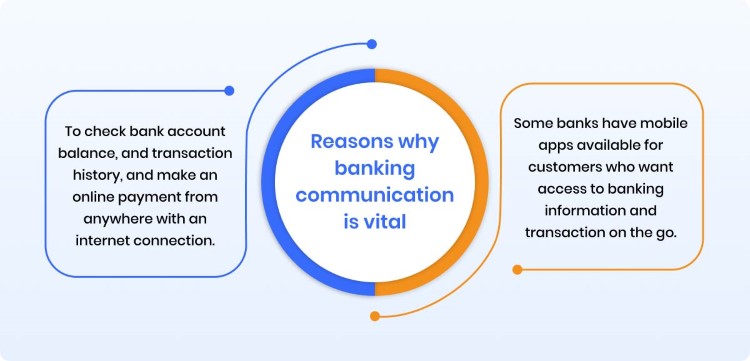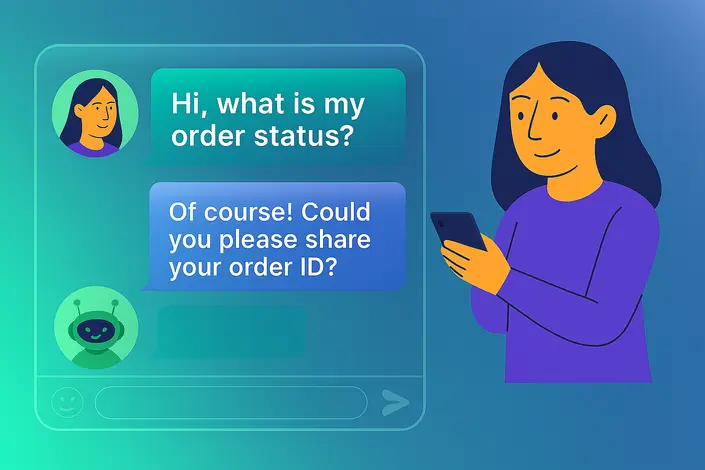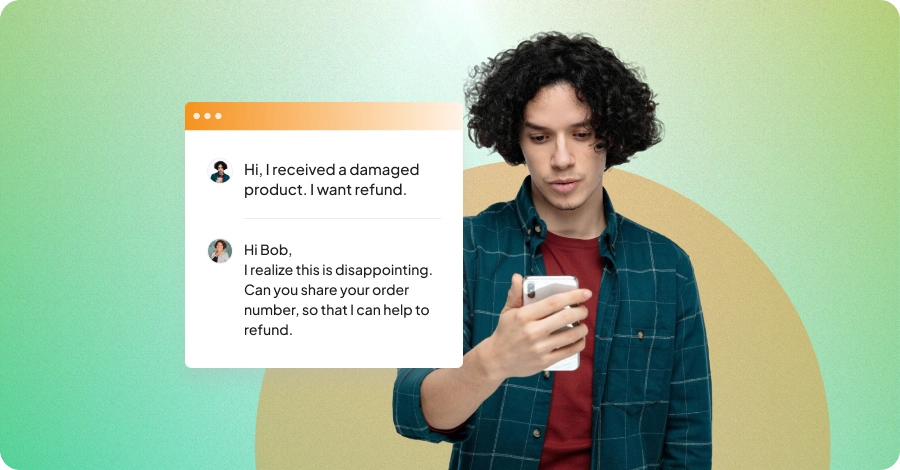8 Best Strategies for Successful Banking Communication
- December 5, 2022
- 14 mins read
- Listen

Banking communication has been undergoing tremendous changes in recent years. Effective customer communication is main in the banking sector, yet it remains one of the biggest challenges faced by many financial institutions.
Delayed responses, inconsistent messaging across multiple communication channels, and lack of personalized customer support are some of the issues faced by banks when it comes to effective customer service.
To address these issues, apart from phone, and email support, banks are turning to multiple new communication platforms such as chatbots and live chat customer service.
Live chat, in particular, has emerged as a game-changing tool for providing real-time customer support, answering queries, and enhancing the overall customer experience. AI chatbots enable banks to automate many of their business operations including customer service.
This blog will guide you through all the aspects related to banking communication- definition, importance, types, used channels, and best strategies to master communication in the modern banking landscape.
What is Banking Communication?
Banking communication refers to the exchange of various information, messages, and data with customers within the banking sector.
It encompasses the use of various communication channels to deliver services to customers, resolve their issues, promote banking products, and build trust among users while ensuring transparency.
The main objectives of banking communication are:
- Building trust and transparency among customers regarding banking products, services, and processes.
- Provide information about financial products, services, and policies to help customers make informed decisions.
- Deliver prompt, consistent, and personalized communication.
- Educate customers about fraud prevention, security measures, and data protection.
- Resolving customer issues.
- Strengthen long-term relationships with customers.
Importance of Banking Communication
A proper communication should be a two-way street to ensure both parties-customers and the banks are kept well informed. This allows customers to be aware of new products and services available, as well as changes occurring in the banking industry. On the other hand, banks can also inform customers about their products and services, share important updates, and provide valuable insights to help them stay well-informed, receive top-notch services, and protect themselves from potential financial losses.
Next, let’s explore the key reasons why effective banking communication is essential:

Product Awareness
Banks offer a wide range of financial products and services to their customers. Through effective communication, they ensure that customers get well-informed about those options, such as loans, savings plans, investment schemes, credit facilities, etc. Proper communication helps them make better financial decisions.
Internal Team Collaboration
Within banks, when the communication is clear even among various departments and teams, it works wonders. It ensures all employees are well informed about the company goals, fosters a positive work culture, and ensures the smooth flow of essential information throughout the organization.
Safeguards Customers from Financial Losses
Banks play a crucial role in educating customers about potential financial risks and fraud prevention. By sharing timely alerts such as transaction notifications, account balances, and safety tips, they can protect customers from scams and unauthorized financial activities.
Prompt Customer Service
Instant and proper banking communication is key to addressing customer queries and resolving their issues effectively. When customers reach out to banks with their queries or concerns, a prompt and empathetic response can significantly enhance their overall banking experience and satisfaction.
Promotes Financial Literacy
Clear communication enables banks to educate customers on managing their finances, covering areas such as financial planning, investment strategies, and credit management. By providing valuable insights, effective communication supports all aspects of financial literacy. Financial literacy empowers individuals to make informed decisions that are best for their well-being.
Builds Brand Reputation
In the highly competitive banking industry, a strong brand reputation is very important for attracting and retaining customers. One of the most effective ways banks can build and maintain this reputation is through consistent and positive communication.
Types of Banking Communication
Banks communicate with customers at every stage of their financial journey, be it for general monetary transactions, new product/service launches, product awareness, or solving problems. In this section, we explore 2 basic types of customer communication used in banks and their use cases in delivering a great experience.
1. Internal Banking Communication
Internal banking communication refers to the exchange of various information, messages, and documents among different teams and departments with a bank. It involves communication between employees, departments, and management to ensure smooth operations and collaborations.
This type of communication is essential for maintaining efficiency, clarity, and consistency across various functions within the bank. This includes a wide range of communication tools that bankers use to interact with one another, such as emails, memos, reports, letters, and other written or digital formats.
2. Customer Communication in Banking
It refers to the process through which banks engage, communicate, and share information with their customers.
Customer communication is a key part of banking. It’s the way banks communicate with their customers, offer various services, and build relationships with them. Being the most important aspect of banking, effective customer communication enables financial institutions to better understand their customers’ needs and provide them with timely, relevant, and personalized information.
Interacting with the customers is also important to make sure that all of them are happy with the services that banks are offering. Effective communication helps to improve customer retention, reduce complaints, and increase overall satisfaction levels.
5 Popular Customer Communication Channels in Banking
Banks use various communication channels to interact with their customers. From offering real-time assistance to sending timely updates and personalized financial advice these channels cater to diverse needs. Here are the most popular customer communication channels in banking:
1. Live Chat
Customer communication channels have been rapidly evolving over the past decade. Live chat is considered to be the most popular communication channel. It enables financial institutions to offer real-time assistance on their websites, mobile apps, and other social media platforms.
REVE Chat is one such AI-powered omnichannel live chat solution for banks that lets the banking agents offer instant help on websites, mobile apps, and other social media channels such as Facebook, Instagram, Telegram, Viber, and WhatsApp. To know more about REVE Chat’s advanced features, SIGN UP for its 14-day free trial today.
2. Chatbot
A chatbot is one of the latest customer communication tools utilized by banks to provide a wide range of automated services to their customers at any time of the day. It is quick, easy, and accessible on a wide range of devices.
The technology behind a bot has been around for quite some time. But this recent spike in consumer interest has been triggered by the ease and access that it offers. Bots are designed to handle, transactional assistance, KYC and onboarding, loan and credit card queries, and the whole customer service round the clock.
REVE AI-powered Chatbot, for example, is one such AI-powered multilingual chatbot that automates customer service and many of the banking operations. Leveraging advanced Large Language Model (LLM) capabilities, REVE Chatbot can process and learn from vast amounts of data and generate prompt responses based on the information. This not only improves customer satisfaction but also optimizes operational efficiency for banks.
3. Call Center
The call center is an efficient customer communication channel in banking. It helps the bank to provide customer-oriented services and also helps in reducing the number of customer complaints. It also benefits customers by offering essential information that may not be readily available online.
Banks utilize call centers for various purposes, including providing customer service, assisting with loans and credit cards, and promoting financial products or services. These centers not only help customers access valuable information about banking offerings but also enable banks to build and maintain strong, long-lasting relationships with their clients.
4. Email
Email remains an important communication channel in the banking sector as it is a formal, reliable, and professional way to engage with customers. Banks utilize email for a variety of purposes, including sending account updates, transaction alerts, and loan-related information, as well as providing customer support, promoting financial products, and gathering feedback through surveys.
Email communication works wonders in maintaining a healthy relationship with customers. Thanks to the numerous benefits and advantages email offers, interactions are more efficient and personalized.
5. Social Media
Social media has become a vital communication channel in the banking sector, offering a direct, real-time connection between banks and their customers. According to a report by the American Bankers Association, 9 in 10 banks (89%) believe social media is important to their banks and 88% are very or somewhat active on their social media accounts. So, yes banks have been using social media to communicate with customers and to increase their brand awareness for a long.
In addition to other communication channels like live chat, websites, and emails, customers also reach out to banks through various social media platforms. Banks would be missing a valuable opportunity if they ignore these platforms to offer assistance.
Challenges in Banking Communication
Providing effective customer communication is important for banks, but they often encounter challenges that can hinder their ability to deliver clear and impactful messages. They must Identify and address these challenges to enhance the overall customer experience. Let’s into those challenges first!
- Maintaining Security and Privacy: The foundation of the banking industry lies in earning and maintaining customer trust, as banks handle highly confidential data. Whether through emails, live chats, or phone calls, customers do share their personal information with banks that has to be safeguarded. Banks must constantly update their cybersecurity measures to protect against threats like phishing attacks and data breaches.
- Consistency Across Channels: Customers interact with banks through multiple communication channels, including phone calls, emails, mobile apps, websites, and even social media. Ensuring that messaging and information remain consistent across these platforms is a significant challenge.
- Jargon and Complexity: Banks often use complex words/jargon for their financial products and services that can confuse customers. They need to use easy and simple language to communicate various policies, fees, and procedures for a better understanding of their customers.
8 Proven Strategies to Enhance Banking Communication
There are many ways to improve overall banking communication and customer experience. Some of these strategies involve changing the banks’ processes. In this section, we will read the key strategies that banks can adopt to improve communication, ensuring that customer feel valued, well informed, get a better experience, and are supported throughout their banking journey.
1. Design a Robust Omnichannel Strategy
Customers interact with their banks across various channels as per their preferences. All these communication channels have to be integrated to offer consistent messaging across every platform. So, to stay competitive and provide exceptional service, banks must embrace multichannel communication, offering seamless and consistent messaging across every touchpoint.
This approach not only caters to the diverse needs of customers but also ensures that customers can reach the bank in the way that best suits them—whether through phone, live chat, email, social media, or in-person interactions and banks can manage all the interactions from a single point.
REVE Chat offers omnichannel integrations where all the communication channels such as websites, social media platforms, and emails can be integrated, and banks can handle all the customer interactions from a single place.
2. Personalize Customer Interactions
Personalization in banking communication can significantly improve customer experience. Customer data fetched from various sources for example using customer details during a live chat session helps support agents to personalize the interaction with customers giving a better experience.
Banks can personalize customer interactions by:
- Customer Data Insights: Banks can use transactional data, and behavioral insights to create personalized experiences. This could include targeted offers, relevant product recommendations, and timely financial advice.
- Personalized Greetings: Addressing customers by name and remembering their preferences from past interactions can create a more personalized, and positive experience.
3. Keep Up with the Latest Tech Trends
The banking industry is constantly evolving, and new technologies are emerging that can help to improve customer engagement. The latest trends include:
- Artificial intelligence (AI): AI is used to analyze data to make better predictions about customers’ behaviors and preferences. It can be used in a wide range of areas, including marketing, fraud detection, and self-service interactions.
- Chatbots: These bots interact with customers using text or voice messages. Bots automate communication and handle multiple chat requests at a time.
- Mobile Banking Apps: The banking app is user-friendly and provides easy access to services such as account management, payments, and financial advice. Push notifications and in-app messages can be used to send relevant updates, reminders, and promotional offers.
4. Focus on Cyber Security Education for Your Customers
One of the best ways to foster customer engagement through communication is by taking security seriously and making sure it’s integrated into every aspect of your business model. In banking specifically, we often see customer data being stolen or compromised through hacking attacks or malware infections on PCs owned by employees in remote locations (such as branch offices).
These types of incidents can have devastating consequences for both individuals and organizations involved because they often result in financial losses for all parties involved. So it is very important to educate customers on cybersecurity best practices and the importance of protecting their personal information to avoid security risks. Banks can provide helpful resources, run awareness campaigns, and offer guidance on identifying and reporting potential security threats.
5. Using a Clear and Simple Language
In the banking industry, we often encounter complex financial terms that can be difficult to understand. Simplifying the language helps ensure that customers can easily grasp the information being shared.
Some Important Tips:
- Clear Messaging: Use simple language when explaining financial products, terms, and policies. Avoid complex jargon and provide easy-to-follow instructions.
- Proactive Communication: Regularly inform customers about changes in terms, interest rates, or fees and any other new updates. Transparency helps build trust and reduces confusion.
6. Set Clear Protocols for Crisis Management
Banks should have well-defined protocols for crisis management to ensure timely, transparent, and consistent communication with customers. For that, they need to create predefined communication strategies and use various communication channels to send timely and accurate information to customers during crises.
Banks should provide timely updates about the situation, explaining the cause of the issue, the steps being taken to resolve it, and also about the impact it may have on services. Transparency is key here to maintain customer trust. Regularly updating customers through their preferred channels—whether via email, text alerts, or social media—ensures they stay informed.
7. Pay Attention to Customer Feedback for Continuous Improvement
Customer feedback is one of the most valuable resources a bank can utilize to improve its products and services. Listening to what customers have to say not only helps to identify areas for growth but also makes customers feel that the bank values their input and is committed to meeting their needs.
To collect valuable feedback banks should actively encourage customers to share their opinions and thoughts. This can be done through various methods such as surveys, online reviews, live chat interactions, or face-to-face meetings with customer service representatives.
8. The Power of Open Communication
Encourage open communication within your banking organization if you want to follow transparency, and encourage teamwork, among employees. Here are some tips for you!
- Meetings: Hosting team meetings at regular intervals allows teams to share important updates, address important concerns, and celebrate achievements, thus creating a space where everyone feels involved and valued.
- Feedback Channels: Establishing multiple avenues for feedback, such as anonymous suggestion boxes, surveys, and regular check-ins, ensures that employees’ voices are heard and their opinions valued. This feedback helps leaders stay connected with the team’s thoughts and requirements.
- Open-Door Policy: Encouraging team leaders to be approachable and open to conversations helps employees feel comfortable sharing their concerns or ideas. This approach builds trust and a positive atmosphere.
Wrapping Up!
Communication plays an important role in shaping the customer’s banking experience. Also, the banking industry is one such industry where they need to handle a huge volume of customers on a daily basis. In such a scenario, effective communication, and real-time assistance are two important things that they need to offer to survive in the business.
Banks need to adopt tools that enhance service delivery and build trust and loyalty among their customers. With REVE Chat’s advanced AI-powered customer communication tools, banks can provide instant, personalized, and secure assistance, ensuring a superior customer experience. To learn more, Sign Up now and enjoy 14-day free trials.
Frequently Asked Questions
Clear and transparent communication ensures customers get proper information on various financial products or services, feel confident that their financial information and transactions are handled securely, and get accurate info at the right time.
Banks use various channels to interact with their customers such as live chat, chatbot, in-person, email, phone calls, and social media.
Banks safeguard sensitive data through encryption, multi-factor authentication, and secure platforms. They also adhere to regulations such as GDPR and PCI DSS to maintain compliance with privacy standards.
Banks should inform customers about any mis happenings and be transparent. They should provide timely updates via SMS, app notifications, email, and social media, use clear, empathetic messaging to explain the issue, and offer alternative solutions or timelines for resolution.
Technology empowers banks to provide instant, personalized communication through live chat and AI chatbots. With mobile banking apps, customers can conveniently manage their accounts in one place, reducing the need for frequent branch visits. Additionally, through automated notifications within the banking apps, customers can get important updates.



